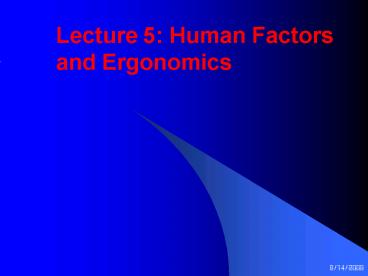Lecture 5: Human Factors and Ergonomics PowerPoint PPT Presentation
1 / 22
Title: Lecture 5: Human Factors and Ergonomics
1
Lecture 5 Human Factors and Ergonomics
2
Overall Goal
- Human Factors/Ergonomics seeks to adapt the work
environment to the capabilities and limitations
of the worker. The results should be increased
productivity, user satisfaction, and reduced risk
of injury.
3
Early History of Human Factors
- Human Centred design began with stone tools
- Role of Warfare in human design
- Chariots, armour, weapons, etc.
- Role of Materials, Energy, and Transport
- Task specialization and organization of labour
- Industrial engineering and scientific management
09/10/99
4
Early design examples
- Following images come from http//www.hfmgv.org
/histories/pic/archive.html
09/10/99
5
A Windmill (pump)
6
Strad from 1703
7
Classic lunchboxes
8
Early telegraph set
9
Steam Traction Engine
10
1912 Election Ballot
11
Early car
12
Plough
13
100 Years Ago
- operators contributed raw muscle power to their
machine - time and motion engineers formulated and applied
a number of principles of motion economy - human factors principles began to be used
explicitly and consistently to design jobs more
effectively and with less strain for the worker. - design of new transportation systems provide a
stimulus to the development of human factors. - Controls designed with the needs and capabilities
of human operators in mind
09/10/99
14
World War II
- Turning point for human factors
- Radar, jet engines, atom bomb, etc.
- Increased importance of user interface (e.g.,
altimeter) - Increased importance of training and losses
during training (e.g., D-day)
09/10/99
15
Altimeter Design
- Altimeter measures how high an aircraft is
flying - Early altimeters were designed like analog
clocks - trainee pilots found it confusing (e.g., 9100
vs. 1900) - controlled flight into terrain problem
- Solution Digital readout plus ascent/descent
indicator
09/10/99
16
HF in the space age
- How do you operate the robotic arm on the space
shuttle? - How do you ensure that a nuclear power plant is
completely safe? - How can you design a helicopter interface so that
a pilot can follow closely the contours of the
terrain while monitoring threats and navigating? - How do you design cell phones that are safe to
operate while driving a vehicle? - How do you design a suitable interface for a
large video on demand system?
09/10/99
17
Status of HF design
- Today, human-centred design is carried out in a
wide range of settings, from the ocean floor to
space. - Each new system and technology presents a new set
of problems to be solved.
09/10/99
18
Case Study 1What is a safe stopping distance for
a car?
19
Factors contributing to overall stopping distance
- The initial vehicle speed
- The weight of the vehicle
- The road conditions
- The reaction time of the driver
- The braking ability of the car
20
Factors contributing to driver reaction time
- the visibility of the target
- the expectations of the driver
- how long the driver has been driving
- how fatigued the driver is
21
Anthropometry
- concerned with the measurement of the physical
features of people - used in the design of seats, chairs, tables,
computer consoles, automobile interiors,
airplance cockpits, and many other work stations
22
Reminder
- Hold regular Project Group Meetings
- Get to know your Mentoring Group
- Start work on your proposal (background research
etc.) - Wednesday lecture this week is on how to write
the proposal - Read first two chapters of text book and first
five or six lectures at the course website
(http//peach.mie.utoronto.ca)

